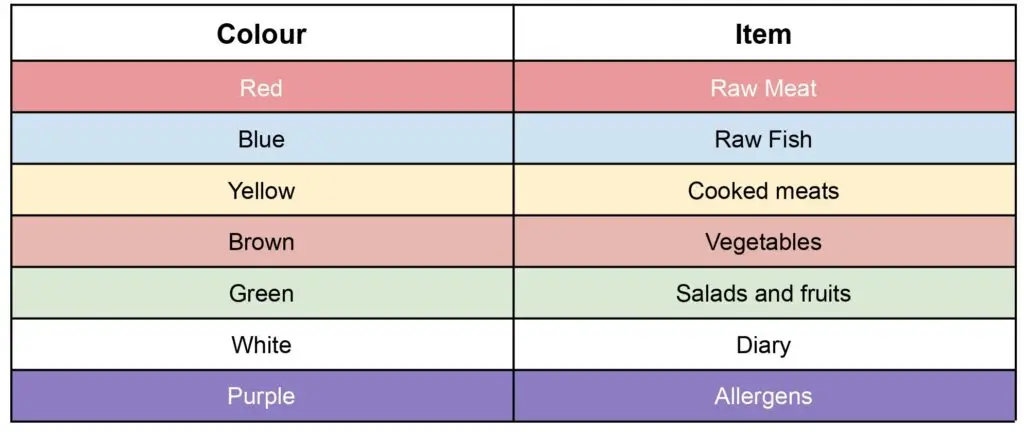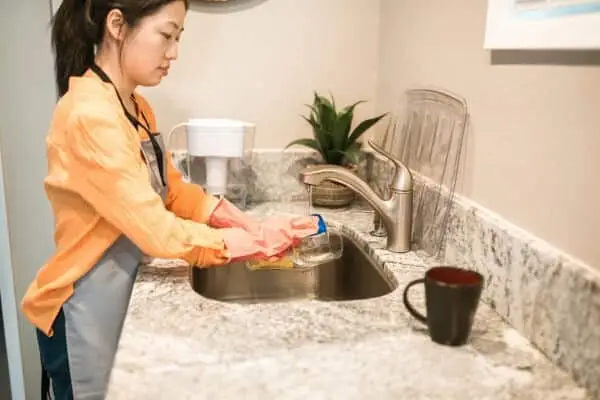The 4 Cs of Food Safety – How To Avoid Illness When Preparing Food
Pexels Licence – RONDAE Productions
When preparing food, we run the risk of bacterial contamination. If harmful microorganisms, like bacteria, spoil our food, it can harbour food-borne illnesses.
Food poisoning is dreaded in catering, though it can quickly occur if you do not take basic precautions. To combat this issue and prevent improper handling, we follow the 4 Cs of food safety. This helpful guide explains each of the Cs and how to prepare food safely so that you can supply nutritional dishes without worrying about sickness.
What Are the 4 Cs?
The four Cs are industry-adopted food safety fundamentals that dictate how you should handle ingredients and prepare meals. You can prevent improper practices and infections by following them and implementing necessary precautions.
1. Cross-Contamination
Cross-contamination is the primary way that bacteria spreads through your kitchen. It occurs when germs move from one food to another, perhaps via contaminated hands, surfaces or kitchen utensils.
To prevent cross-contamination, you should always separate cooked and raw food, whether in a fridge or on your surfaces. Wipe down any surface with an anti-bacterial cleaner and thoroughly wash every utensil after use.
Many kitchens colour-code equipment like knives and chopping boards and exclusively use them with particular foods. Here is a guide to that system:

Cross-contamination can also affect those with allergies. When dealing with an allergen, like peanuts or gluten, you must clean your hands, surfaces and utensils before preparing more food. That way, you prevent them from contaminating food intended for those with allergies, protecting them from life-threatening reactions.
2. Cleaning
Bacteria collects on your kitchen surfaces and equipment and can easily contaminate your food. Clean them regularly to kill these harmful microorganisms and prevent cross-contamination in your kitchen. A clean-as-you-go approach allows you to use surfaces and utensils that have touched raw ingredients.
You should:
- Disinfect surfaces with anti-bacterial spray and bleach
- Clean utensils with detergents like washing up liquid
- Use separate cloths for different jobs – never clean your surfaces with a cloth that you have used on the floor; it will spread germs around the kitchen. Don’t forget to wash your cloths regularly
3. Cooking
Thorough cooking kills bacteria effectively. Harmful bacteria will rapidly multiply between 5 and 63oC but cannot survive in high temperatures. Once your food reaches 75oC or above, almost all bacteria will be killed.
Always check that the coldest part of your food has reached this temperature. You may find that the outside temperature is hot, but the inside falls below the safe threshold and still contains harmful bacteria. For accuracy, you should temperature probe multiple parts of your food, especially the middle.
If you are reheating food, it must reach an even higher temperature. Check that it is piping hot all the way through before eating, especially if you are using a microwave. You may have to stir regularly to heat the whole item. Finally, remember that you should only ever reheat food once.
4. Chilling
Bacteria can multiply when we store ingredients. However, their growth rate is far lower at temperatures below 5oC. Consequently, we set our fridges to between 1 and 4oC and freezers to -18oC or lower. At this temperature, growth stops.
You should always chill:
- Food with a use-by date
- Cooked Food
- Some prepared dishes like desserts
If you are ever in doubt, check the manufacturer’s storage guidance on the packaging.
Sources of Bacteria in Your Kitchen
Unfortunately, there are many sources of bacteria in our kitchens, so following the 4 Cs is essential for preventing contamination and food-borne illnesses. Here are some of the most common sources that you should treat with care:
- Raw Food
- Water
- Insects
- Animals
- Dust
What Factors Promote Bacteria Growth?
When considering food handling and preparation, we need to understand bacteria growth and the environments that promote it. Bacteria need four things to grow and thrive:
- Warmth
- Moisture
- Food
- Time
Therefore, we need to eliminate these factors at all costs.
How To Keep Your Food Safe
You can apply the four Cs to your kitchen in different ways to eliminate bacteria and the conditions they need to grow. Here are some ways to keep your kitchen and meals bacteria-free:
Clean Promptly
Always clean immediately to tackle the food and time bacteria needs to multiply. You should dispose of food debris and waste as soon as it appears and put food away within two hours of eating.
Store Food Safely
When storing food, you should always follow the manufacturer’s recommendations, as listed on the packaging. Place any cooked dishes, food with a use-by date and other prepared meals like salads or desserts in the fridge.
Separating your raw and cooked foods is vital, and you should also check whether they can affect each other. Be aware that blood and juices can drip, and placing cooked items underneath raw products may lead to cross-contamination. Ideally, if you have the facilities, you should use one fridge for raw items and another for prepared food.
Keep your dry ingredients dry. Water can trigger bacteria growth, so you should maintain moisture-free cupboards and be aware of any spillages or dampness.
Transport Food Safely
If you transport food to another location, you move out of a controlled, clean kitchen and face higher risks. Therefore, you must use containers that prevent contamination and separate raw and cooked products.
You should also consider the temperature of your packaging. Chilling the food on its journey prevents bacteria growth; opt for cool packs and refrigerated vans to keep the items cool.
Food Safety Inspections
UK authorities police food laws and standards with food safety inspections. An officer will visit your premises to determine whether you are following appropriate practices to produce safe food. You will then receive a food hygiene rating from 0-5, with 5 being ‘very good’ and 0 being ‘urgent improvement required’. These inspections are random and unannounced to assess your food handling when you are not expecting it.
Train Your Staff to Handle Food Safely
As a food-handling business, you are legally obligated to train your staff to prepare food safely. With our courses, you can easily teach them everything they need to know and prevent dangerous mistakes.
At Caredemy, we offer a selection of affordable, CPD-accredited online food hygiene courses, ranging from basic food safety to allergy awareness to nutrition. We even have Level 2 courses written by Environmental Health Officers. They provide all the necessary education and training to prepare nourishing meals safely. Plus, you can take them individually or in groups, making them perfect for team training sessions.
Simply explore our range and sign up today to progress your skills. Alternatively, you can contact our friendly team for more information and guidance.
FAQ
What are the 4 Cs of food hygiene and safety?
The four Cs of food safety are cleaning, cross-contamination, cooking and chilling.
Why are the 4 Cs important?
Following the 4 Cs of food safety can kill bacteria and prevent them from contaminating your food and causing illness.
{ “@context”: “https://schema.org”, “@type”: “Article”, “mainEntityOfPage”: { “@type”: “WebPage”, “@id”: “https://caredemy.co.uk/4-c-food-safety/” }, “headline”: “The 4 Cs of Food Safety – How To Avoid Illness When Preparing Food”, “description”: “Food poisoning is dreaded in catering, though it can quickly occur if you do not take basic precautions. To combat this issue and prevent improper handling, we follow the 4 Cs of food safety. This helpful guide explains each of the Cs and how to prepare food safely so that you can supply nutritional dishes without worrying about sickness.”, “image”: “https://caredemy.co.uk/wp-content/uploads/2023/03/Washing-Up-Pexels-Licence-RONDAE-Productions.webp”, “author”: { “@type”: “Organization”, “name”: “Caredemy”, “url”: “https://caredemy.co.uk/” }, “publisher”: { “@type”: “Organization”, “name”: “Caredemy”, “logo”: { “@type”: “ImageObject”, “url”: “https://caredemy.co.uk/wp-content/uploads/2022/11/cropped-cropped-cropped-cropped-cropped-Caredemy_multiple_logosb-e1611314968243-1-4.png” } }, “datePublished”: “2023-03-10”, “dateModified”: “2023-03-10” } { “@context”: “https://schema.org”, “@type”: “FAQPage”, “mainEntity”: [{ “@type”: “Question”, “name”: “What are the 4 Cs of food hygiene and safety?”, “acceptedAnswer”: { “@type”: “Answer”, “text”: “The four Cs of food safety are cleaning, cross-contamination, cooking and chilling.” } },{ “@type”: “Question”, “name”: “Why are the 4 Cs important?”, “acceptedAnswer”: { “@type”: “Answer”, “text”: “Following the 4 Cs of food safety can kill bacteria and prevent them from contaminating your food and causing illness.” } }] }

